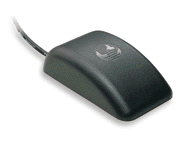

Visit Garmin's GPS 35-HVS web page.
Download
| Specifications |
| Performance |
| Receiver:
Differential-ready
12 parallel channel receiver tracks and uses up to twelve
satellites to compute and update a position. Acquisition Times:
Update
Rate: 1 second, continuous
(programmable from 1 second to 15 minutes)
Velocity accuracy: 0.1 m/s RMS steady state (subject to Selective Availability) Dynamics: 999 knots; 6g's Interfaces:
Inputs:
Outputs:
Raw
measurement output for both psuedorange and phase data Antenna: Built in
|
| Physical |
| Size: 2.22"
(w) x 3.79" (l) x 1.05" (h) (56.4mm x 96.3mm x
26.7mm) Weight: 3.88 oz. (110 g), not including cable Environmental:
|
| Power |
Input
Voltage:
Backup Power: Internal rechargeable 3V Lithium coin cell battery , up to 10 year life
|
| Specifications are subject to change without notice. |
About Pulse-Per-Second output (from technical spec chap. 4.4)
4.4 One-Pulse-Per-Second Output
The highly accurate one-pulse-per-second output is provided
for applications requiring precise timing
measurements. The signal is generated after the initial position
fix has been calculated and continues
until power down. The rising edge of the signal
is synchronized to the start of each GPS second.
Regardless of the selected baud rate, the information transmitted
by the GPS 35LP receiver is
referenced to the pulse immediately preceding the NMEA 0183 RMC
sentence.
The accuracy of the one-pulse-per-second output is maintained
only while the GPS 35LP can compute a
valid position fix. To obtain the most accurate results, the one-pulse-per-second
output should be
calibrated against a local time reference to compensate for cable
and internal receiver delays and the
local time bias.
The default pulse width is 100 msec, however; it
may be programmed is 20 msec increments between 20
msec and 980 msec as described in $PGRMC Section 4.1.3 character
<13>.
University of Bergen, Norway
Institute of Solid Earth Physics
Last update: 24. august 2000 (OM)